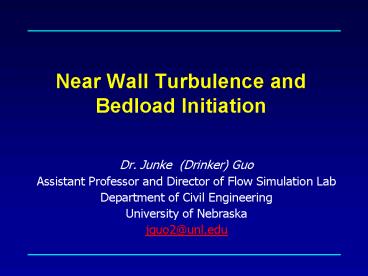Near Wall Turbulence and Bedload Initiation - PowerPoint PPT Presentation
1 / 21
Title:
Near Wall Turbulence and Bedload Initiation
Description:
What is the gap: (1) buffer layer model between the viscous and the inertia ... Bedload: Sediment is transported by rolling, sliding and saltation. Bedload initiation: ... – PowerPoint PPT presentation
Number of Views:85
Avg rating:3.0/5.0
Title: Near Wall Turbulence and Bedload Initiation
1
Near Wall Turbulence and Bedload Initiation
- Dr. Junke (Drinker) Guo
- Assistant Professor and Director of Flow
Simulation Lab - Department of Civil Engineering
- University of Nebraska
- jguo2_at_unl.edu
2
CONTENTS
- Overview
- Background
- Near wall turbulence
- Bedload Initiation
- Potential applications bridge scour
- Summary and Conclusions
3
OVERVIEW
- Topic Near wall velocity profile Bedload
initiation - What we know The linear law in the viscous
sublayer the log law in the inertia layer the
Shields diagram for bedload initiation - What is the gap (1) buffer layer model between
the viscous and the inertia layer (2) roughness
model for transitional (3) foundation for the
Shields diagram. - Why important (1) without an accurate buffer
layer model, CFD modeling is expensive (2)
bedload transport and bridge scour prediction can
never be improved. - What we propose (1) an accurate mean flow model
for near wall turbulence (2) an accurate bedload
initiation criterion.
Guo
3
4
BACKGROUND
- Turbulence Irregular, random motion of fluids.
- Why turbulence? (Re inertia / viscous)
- Method (dimensional analysis, asymptotic, mean
flow fluctuation) - Near wall turbulence
- Vertical structure Buffer layer law?
- Boundary condition Transitional roughness
function?
5
BACKGROUND (Cont.)
- Bedload Sediment is transported by rolling,
sliding and saltation. - Bedload initiation
- Under what condition, bedload starts to move?
- The Shields diagram (1) How to connect near wall
turbulence to the shields diagram? (2) How about
small particle initiation?
Guo
CE, UNL
5
6
- OBJECTIVES
- Find a general mean flow model for near wall
turbulence, which includes the buffer layer law
and roughness effect. - Find a theoretical bedload initiation criterion,
which includes the small particle initiation.
7
NEAR WALL TURBULENCE IDEA
8
NEAR WALL TURBULENCE BUFFER LAYER
- The arctangent law in the inner region
- Idea The inner region law connects the log law
through the additive constant B.
9
NEAR WALL TURBULENCE LAW OF THE WALL
- Composition of the arctangent law and the log
law - Determination of the value of C?
- Comparison (previous figure)
10
NEAR WALL TURBULENCE ROUGHNESS
- According to Nikuradse (1933), roughness only
shifts the velocity profile with a constant. For
the log law, we have
Guo
CE, UNL
10
11
NEAR WALL TURBULENCE ROUGHNESS
- The above log law can be rewritten as
- The roughness effect in the near wall
12
NEAR WALL TURBULENCE TEST WITH DATA
? Smooth bed
Rough bed
13
NEAR WALL TURBULENCE SUMMARY
- The proposed mean velocity profile model
reproduces all asymptotes, fills the gap in the
buffer layer, and accounts for the effect of
roughness. - The proposed model agrees well with laboratory
data in hydraulically smooth, transitional, and
rough flow regimes.
14
BEDLOAD INITIATION ANALYSIS
- The hydrodynamic force depends on the flow
velocity, u, acting on the particle.
Guo
CE, UNL
14
15
BEDLOAD INITIATION ASSUMPTIONS
- The drag coefficient, CD, is similar to that
of sediment settling. - The acting velocity, u, is estimated by the
proposed near wall velocity profile model.
16
BEDLOAD INITIATION CRITERION
- where
17
BEDLOAD INITIATION TEST WITH DATA
Guo
CE, UNL
17
18
BEDLOAD INITIATION SUMMARY
- The proposed criterion rationally connects the
near wall turbulence and bedload initiation. - The proposed criterion is valid for all particle
Reynolds numbers, including small particle
initiation.
Guo
CE, UNL
18
19
POTENTIAL APPLICATIONS BRIDGE SCOUR
- Bedload initiation criterion is the most
important parameter in bridge scour predictions. - The immediate application of the proposed
criterion is to predict the general scour depth
due to flow contractions. - Combining the proposed criterion with CFD
software, the time rate of local scour depth due
to floods can be simulated.
Guo
CE, UNL
19
20
SUMMARY AND CONCLUSIONS
- We completed our two objectives by making two
contributions - We propose a universal law for near wall
turbulence, which fills the gaps in the buffer
layer and the effect of transitional roughness
and - We derive a universal criterion for bedload
initiation, which rationally connect the
turbulent boundary layer and bedload initiation
and includes small particle initiation. - We expect this work will significantly improve
bedload transport modeling, and bridge scour
prediction.
21
Thanks!!































